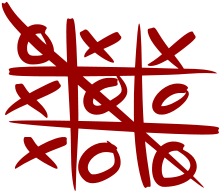Futile game
In game theory, a futile game is a game that permits a draw or a tie when optimal moves are made by both players.[1][2] An example of this type of game is the classical form of Tic-tac-toe,[3] though it doesn't necessarily apply to variants. It also does not apply to intransitive games, such as iterated prisoner's dilemma or rock–paper–scissors, in which there is no path to a draw or every strategy in the game can be beaten by another strategy.[4]
See also
References
- Steinhaus, H. (1999). Mathematical Snapshots (3rd ed.). New York: Dover. p. 16.
- Weisstein, Eric W. (2002). CRC Concise Encyclopedia of Mathematics (2nd ed.). CRC Press. p. 1129.
- Wang, Hao (2014-09-22). Popular Lectures on Mathematical Logic. Courier Corporation. ISBN 9780486171043.
- Ashlock, Daniel (2006-04-04). Evolutionary Computation for Modeling and Optimization. Springer Science & Business Media. ISBN 9780387319094.
This article is issued from Wikipedia. The text is licensed under Creative Commons - Attribution - Sharealike. Additional terms may apply for the media files.

